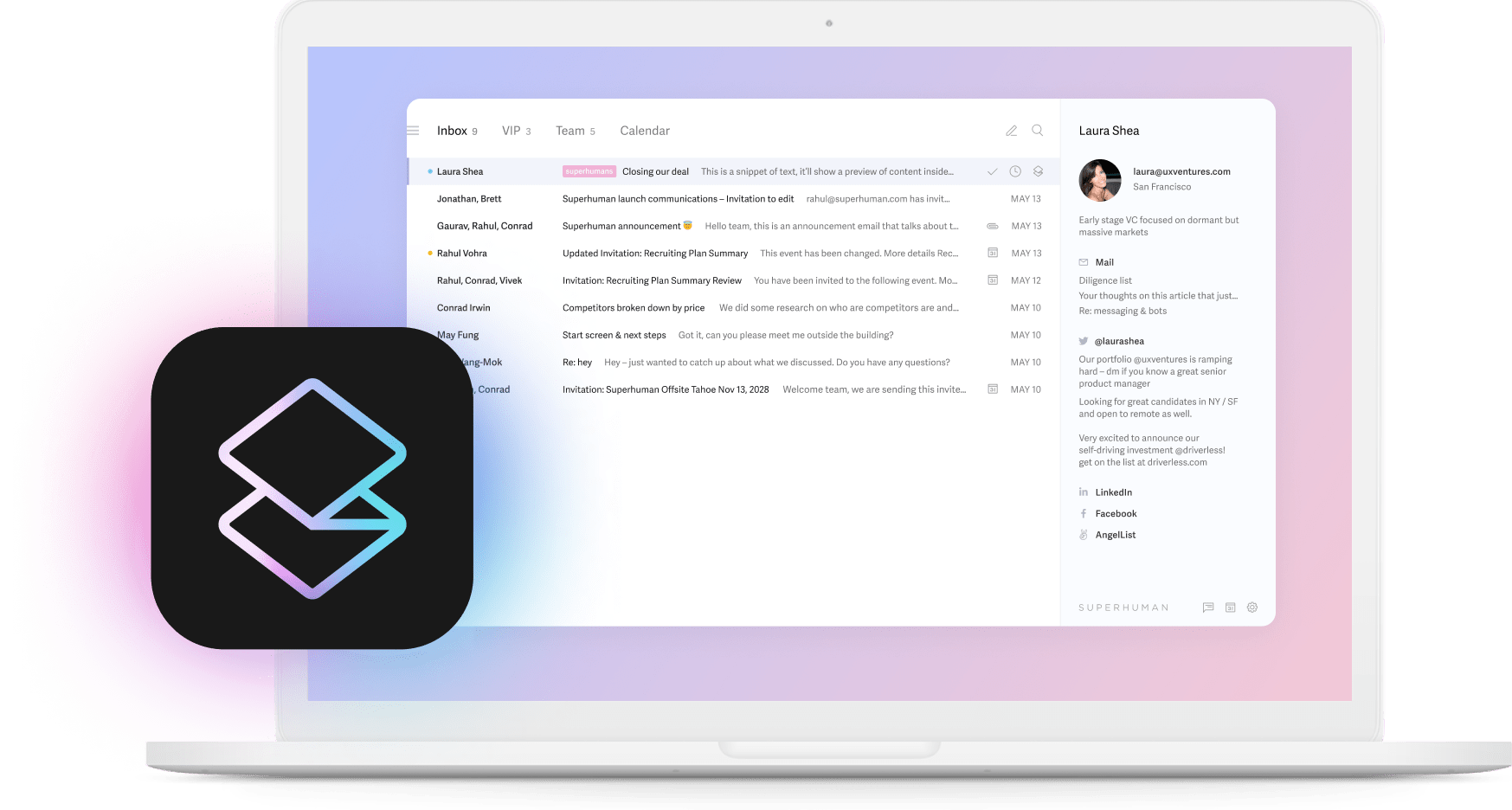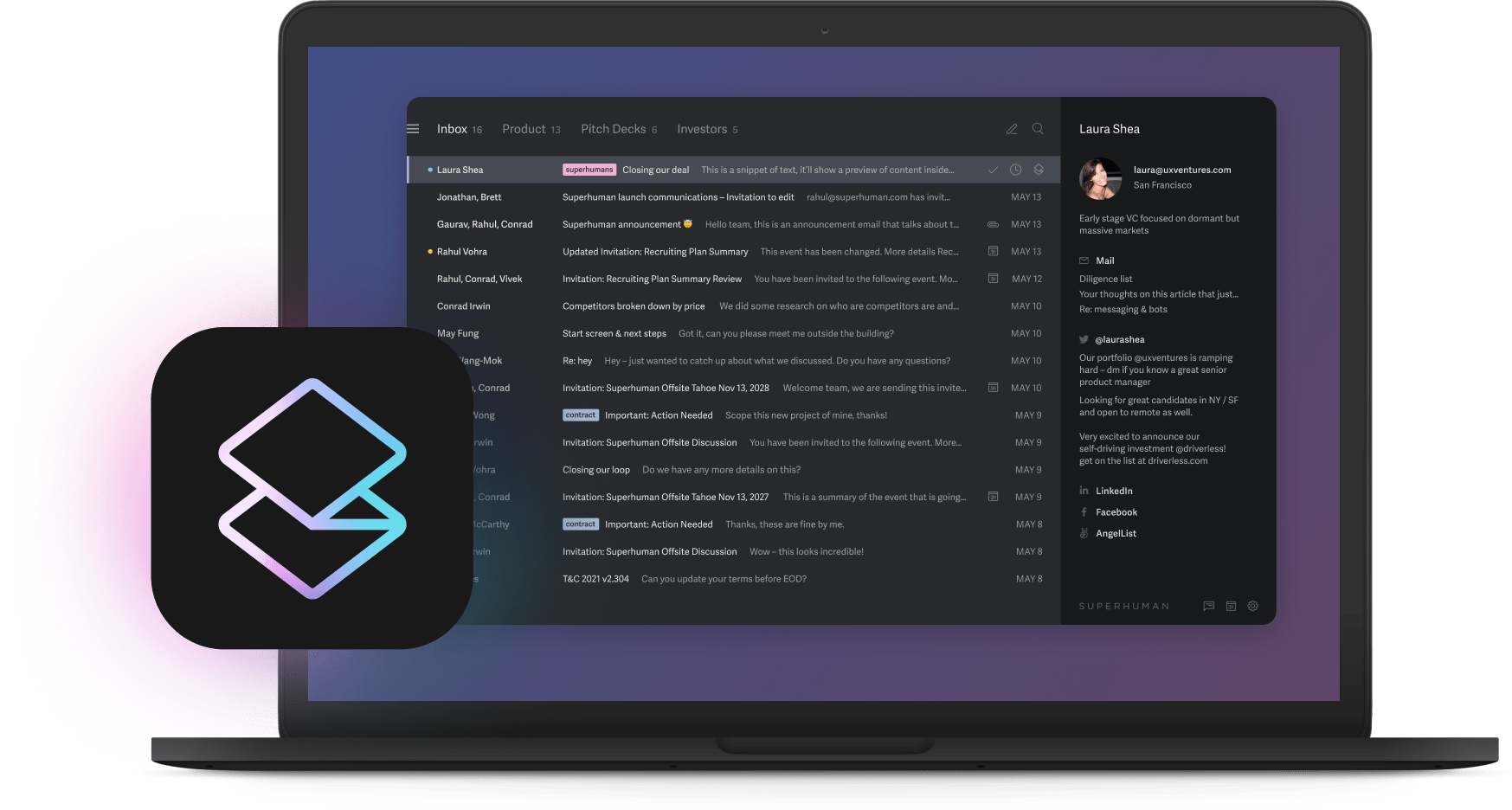
Your inbox hits 200 unread emails before lunch, three urgent deals are buried somewhere in the chaos, and you're drowning in routine tasks when you should be focusing on strategy and growth.
Here's what's interesting though. Most people think they need to get better at managing email. But what if the real solution is to stop managing it yourself?
AI agents for workflow automation handle the repetitive work while you focus on what moves the needle. They learn and get smarter over time, unlike basic rules that break when things change, plus they work 24/7 without needing breaks or vacation, and you can scale them up without hiring more people.
The nine agents covered here can work alone to solve specific challenges or together as a coordinated system that transforms your entire workflow.
1. Email sorting agent
An email sorting agent transforms chaos into clarity by organizing every message that hits your inbox. No more morning panic attacks over 47 unread emails.
You grab coffee, open your laptop, and instead of scanning endless subject lines, you see exactly what needs your attention. Three messages from your biggest client sit in your VIP section. That contract you've been waiting for is flagged as urgent. The spam and newsletters are tucked away where they belong.
The agent analyzes each message's content, sender reputation, and your past behavior to assign priority scores, ensuring critical communications surface immediately while routine notifications stay out of your way.
Superhuman's Split Inbox demonstrates this perfectly. Instead of one overwhelming inbox, you get organized sections that separate VIP messages from everything else. Auto Summarize lets you scan email conversations at a glance without reading entire chains. The system learns your patterns, getting smarter about what you consider urgent versus what can wait.
Your day changes completely. You miss fewer VIP messages because they're automatically flagged. Response times improve because urgent emails don't get buried under newsletters. Most importantly, you stop playing email detective every time you open your inbox.
Setting up an email sorting agent takes three steps:
Define your VIP contacts and urgency rules for anyone from your executive team, key clients, or family members.
Connect the agent to your existing systems through APIs so it can access your calendar, CRM, and project management tools for context.
Set metrics like response time improvements or inbox processing speed to track the impact.
Some executives worry about missing important emails from new contacts. Modern sorting agents use conservative filtering. When in doubt, they mark something as important rather than filtering it out. You maintain full control over the rules and can adjust them as your priorities change.
2. Smart drafting agent
You stare at a blank email, knowing exactly what you want to say but can't find the right words. A smart drafting agent solves this by turning rough ideas into polished emails that sound like you wrote them.
Here's how it works. You type "follow up on pricing discussion," and the agent creates a complete email that matches your tone, includes the right context, and maintains your voice. Superhuman's Write with AI analyzes previous messages you've sent to specific recipients and matches your established tone and voice, learning over time through your natural email writing.
If a drafted response goes out with a mistake, most modern clients now allow quick email unsending before the recipient opens it.
Start with reusable prompts for common emails like "Schedule meeting with client," "Send project update," or "Request vendor information." The agent learns from each interaction and gets better at capturing your style.
These agents have limitations though. They excel at routine emails but struggle with complex situations that need emotional intelligence. They work best for standard business communications where consistency and speed matter most. When you use AI drafting tools, you can respond to more emails in the same time while maintaining quality and supporting personalization.
3. Follow-up and reminder agent
Half your best opportunities die in silence because someone forgot to follow up. A follow-up and reminder agent fixes this by tracking every conversation that needs a response and nudging you when it's time to reconnect.
The agent scans your email conversations and spots the ones going cold. You send a proposal and don't hear back in three days? Flagged. A client promises to "circle back next week" and goes silent? You get a reminder. The agent learns your communication patterns and suggests optimal timing for each follow-up based on the relationship and context.
Superhuman's Auto Reminder showcase this capability perfectly. Schedule emails to send at the perfect moment while Reminders ensure nothing falls through the cracks. Messages stay queued until the agent dispatches them automatically.
The business impact is immediate. Sales teams see stalled deals suddenly move forward because the right follow-up happened at the right time. Project leaders keep initiatives on track because stakeholders get gentle nudges when deliverables are due. Teams report increased productivity because these systems eliminate the cognitive burden of remembering every pending task.
Start simple. Set your follow-up preferences and define default intervals for different conversation types. A proposal might get a three-day follow-up, while a casual networking email waits two weeks. The agent learns from your behavior and suggests increasingly accurate timing.
The most sophisticated agents integrate with your CRM and project management tools, creating seamless workflows where follow-ups trigger automatically based on deal stages or project milestones. This eliminates the mental energy spent wondering "Did I follow up with Sarah about the contract?" because the agent handles it for you.
4. Meeting scheduling agent
You get an email asking for a meeting, and before you can even check your calendar, replies are flying back and forth. "How about Tuesday?" "I'm in client calls all day Tuesday." "Wednesday morning?" "I have a board meeting until 11." Three days and twelve emails later, you finally land on a time slot.
Meeting scheduling agents eliminate this productivity drain. They scan multiple calendars at once, spot overlapping availability, and propose optimal meeting times in seconds. Many also generate video links and send calendar invites with all the details, while some advanced tools can book conference rooms.
The agent connects to Google Calendar, Microsoft 365, or other scheduling systems. When someone requests a meeting, it analyzes everyone's schedules, considers time zones, factors in travel time between locations, and accounts for meeting preferences like avoiding back-to-back calls.
Tools like Calendly automate this entire process. Share your scheduling link, and prospects can book directly into your available slots without the email back-and-forth. For teams, Acuity Scheduling handles complex multi-person scheduling across different time zones.
For executives juggling 20+ meetings per week, the time savings add up fast. If each meeting typically requires 10 minutes of scheduling coordination, that's over three hours weekly just for calendar management.
You'll need to set clear permissions and preferences upfront. The agent needs access to your calendar data, default meeting lengths, preferred time slots, and booking rules. You might specify no meetings before 9 AM or block focus time from 2-4 PM daily.
The real victory comes from inbox decluttering. Those endless scheduling email conversations disappear completely. Instead of drowning in "What about Thursday?" messages, your inbox stays focused on work decisions.
5. Summarization and insight agent
Your inbox contains a 47-message email conversation about a client proposal that started three weeks ago. Reading through everything would take 20 minutes you don't have. A summarization agent handles this in seconds, delivering the key decisions, action items, and outstanding questions you need to know.
These agents analyze lengthy email conversations and documents, then extract the most critical information into digestible summaries. Think of them as your personal research assistant who never gets tired of reading through complex conversations and always knows what matters most.
Superhuman’s Auto Summarize excels at email summarization, automatically generating action items and key takeaways from emails. For document summarization, tools like Notion AI can digest lengthy reports and extract the essential points you need for decision-making.
Customize these summaries for different purposes. Executive snapshots focus on decisions and budget implications. Technical deep dives preserve important specifications and requirements. Action lists extract next steps and deadlines. The format adapts to what you need in the moment.
Instead of getting lost in long CC and BCC email chains, the summarization agent delivers a concise overview of what matters.
This requires some upfront work. Train the agent on your company's terminology and priorities. Configure integration points with your email system and internal databases properly. The agent learns your preferences over time, getting better at identifying what information you consider most important.
The main limitation involves nuance and context. These agents excel at extracting facts and decisions but sometimes miss subtle implications or emotional undertones that might be crucial for sensitive situations. They work best for routine information processing, with human oversight for complex or high-stakes communications.
6. Data entry and CRM update agent
Your sales team just finished a client call, and now someone needs to manually log every detail into Salesforce. Contact information, project requirements, next steps, budget discussions. This happens dozens of times per week, eating up hours that could be spent selling.
Data entry and CRM update agents solve this by automatically extracting key information from your email conversations and populating your CRM systems. No manual work required. These agents scan through emails to identify contact details, project specifications, meeting outcomes, and deal stages, then push this data directly into platforms like Salesforce, HubSpot, or Pipedrive.
The agent analyzes email content using natural language processing to identify specific data types like phone numbers, company names, project timelines, and budget figures. It validates this information against existing CRM records to prevent duplicates and keeps data consistent across your entire sales pipeline.
Zapier connects your email to CRM platforms, automatically creating leads when prospects email you. Clay takes this further by enriching contact data and updating CRM records with company information, social profiles, and other relevant details pulled from public sources.
This automation delivers three key benefits:
- It eliminates manual data entry errors that happen when reps rush through administrative tasks between calls
- Your CRM becomes more complete and current since information gets captured immediately after every customer interaction
- Sales forecasting becomes more reliable because deal progression and pipeline data stay current automatically
Your IT team will need to establish secure API connections between email systems and CRM platforms while ensuring compliance with data protection regulations. Pay attention to personally identifiable information handling, audit trails, and role-based access controls.
7. Analytics and reporting agent
You know that feeling when you're drowning in emails but have no idea if you're getting better at managing them? An analytics and reporting agent turns your communication chaos into clear, actionable data that shows exactly where you're winning and where you're still bleeding time.
Think of it as your email performance coach. This agent pulls data from everywhere like read receipts, calendar events, CRM updates, and your email habits, then creates dashboards that matter. You'll see metrics like:
- How fast you hit inbox zero
- Whether you're meeting response time commitments
- Which workflows save you the most hours each week
These agents track the things you can't easily measure yourself:
- How many emails does your sorting agent handle automatically?
- Which smart drafting prompts save you the most time?
- Are your follow-up reminders improving deal closure rates?
Without this visibility, you're flying blind.
Mixpanel tracks user behavior across your email workflows, showing which automation saves the most time. For email-specific analytics, tools like EmailAnalytics provide detailed insights into response times, email volume patterns, and productivity metrics across your team.
Start by defining three key performance indicators that matter to your role. Maybe it's average response time, emails processed per hour, or time spent in your inbox daily. Set up data access permissions so the agent can pull from your email client, calendar, and any integrated systems. Choose your reporting frequency like daily snapshots for quick wins, weekly summaries for trends, monthly deep dives for strategic planning.
Privacy matters here. Make sure your analytics agent anonymizes sensitive information and follows your organization's data governance policies. The real power comes from continuous improvement. Your analytics agent shows you which automation investments pay off and which ones need adjustment, turning email management from guesswork into science.
8. Workflow orchestrator (multi-agent system)
Think of a workflow orchestrator as the conductor of an AI symphony. Instead of relying on a single AI agent to handle everything, you deploy multiple specialized agents that work together seamlessly. One agent handles email triage, another drafts replies, and a third schedules follow-ups. The magic happens when they coordinate these tasks automatically.
Here's how it works in practice. Your email sorting agent identifies a high-priority message from a key client asking about project timelines. It immediately flags this message and passes the context to your smart drafting agent, which crafts a response using your writing style and pulls relevant project data from your CRM. Meanwhile, your scheduling agent checks your calendar and proposes three meeting slots. All of this happens before you even see the original email.
The setup has four connected parts. Perception agents like Microsoft Power Automate watch your email, calendar, and business systems. Decision agents like Zapier look at this information and figure out what to do next. Action agents like IFTTT handle tasks like sending emails or updating databases. Learning agents like Datadog track what works and make the system better over time.
Multi-agent systems represent the next step beyond single-purpose automation. They create compound productivity benefits because each agent makes the others more effective. Your email processing doesn't just get faster, it becomes predictive and proactive.
Start simple when building this. Connect two agents first rather than trying to build everything at once. Link your email sorting agent to your CRM update agent. Once that runs smoothly, add drafting capabilities.
The key is choosing agents that naturally work well together. Your Superhuman inbox becomes the central hub where these coordinated agents operate, turning email management from a reactive chore into an automated advantage that runs while you focus on strategic work.
9. Custom fine-tuned agent (built on your data)
Your AI agent knows your company's specific processes, your industry terminology, and how your team communicates internally. Custom fine-tuned agents learn from your proprietary data like internal wikis, past email conversations, and company documentation.
Building one takes four steps:
Collect your dataset from internal communications, knowledge bases, and relevant documents.
Fine-tune the AI so it learns your organization's unique language patterns and business logic.
Set up proper permissions and access controls.
Let the agent adapt continuously as it processes more of your company's data.
OpenAI's fine-tuning capabilities let you train GPT models on your specific data, creating agents that understand your industry terminology and communication style. For larger enterprises, platforms like Hugging Face provide more control over the training process and model deployment.
Security matters more here than anywhere else. You're feeding sensitive company information into an AI system, so proper data handling becomes non-negotiable. Encrypt everything in transit and at rest. Set up detailed audit trails. Make sure your setup meets industry compliance requirements from day one.
Start small with a pilot project. Create a sandbox environment where you can test the agent's performance without risking production systems. Organizations see the biggest success when they begin with limited scope and expand gradually.
Work closely with your IT team to build a 30-day minimum viable product. This gives you enough time to see real results while keeping the project manageable. Focus on one specific workflow initially, like automatically categorizing support tickets using your company's historical data.
The competitive advantage is clear. While your competitors use generic AI tools, your custom agent understands your business inside and out. It knows your product names, your customer segments, and your internal processes. Businesses deploying specialized AI agents report higher accuracy rates and better adoption compared to generic solutions.
Getting started with AI agents
These AI agents work best when you start small and build up. Pick one or two that solve your biggest problems first, then expand from there.
Whether you're setting up a single agent or building a complete multi-agent system, the key is choosing tools that fit your workflow. Start with the problems that eat up most of your time, then let the agents handle the routine work while you focus on what really matters.





